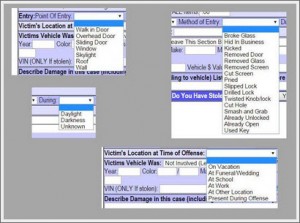
Latin for “method of operation,” modus operandi is commonly considered in criminal investigations, when officers or analysts assess potential connections between similar cases. Criminals frequently have behaviors or styles that form a signature, a certain way of doing things.
Last week, I helped teach a seminar in Oregon, “Crime Analysis for Police Executives,” sponsored by DOJ’s Bureau of Justice Assistance and the International Association of Directors of Law Enforcement Standards and Training. The training teamed crime analysts with their command staff. As with most trainings, I learned as much as I imparted, a lot of which took place in the informal conversations during breaks.
When you rub shoulders with a group of crime analysts, they often lament the lack of solid M.O. data in database fields, which makes queries difficult, impossible, or not entirely accurate. Incomplete entries, or even ignoring the M.O. fields entirely is a rather common problem. If you want police officers to use those fields reliably, there are two things that can be done to make this more likely.
First, make sure officers understand the value and importance of the data. Do some training, so officers understand that the only way you can provide a map or list of robberies committed by a suspect who threatens victims with a knife is if the officers have completed the weapon type and usage fields in their Incident Reports. When officers see the results of providing the M.O. data, they will be encouraged to collect it with more diligence.
Second, ensure that the system for collecting M.O. data is as straightforward as possible. I have seen some multi-page M.O. forms that make my eyes glaze over. Keep the number of fields reasonable, and the selection of values for those fields concise. Ideally, an officer completing a report on an assault would not have to wade through all of the fields that only pertain to other crimes, like vandalism, auto theft, or robbery in order to get to those that apply to assault.
Several years ago, when we were developing an online Incident Report at LPD, we were inspired by TurboTax: if you have no self-employment income, you never see all the additional fields associated with that particular circumstance. Similarly, if you are reporting a burglary in Lincoln, and have entered the incident code for that crime type, the only M.O. fields you’ll see are those that relate specifically to burglary: point of entry, method of entry, day/night, and victim activity. The choices in the dropdown are relatively few. It’s great data when an officer or analysts wants to know something like, “Where are any other burglaries where entry was made through an overhead door left standing open?”
Here are a few screen shots clipped from the Incident Report entry screen, that show the M.O. fields and dropdown values for burglary.

Visit Director Casady’s blog.